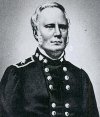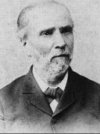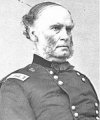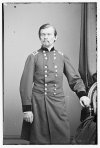Skirmish at Pearson's (Pierson's) Creek
 While headquartered in Springfield, Missouri, Major General Sterling Price found out that the Federals had occupied Lebanon, Missouri, just 55 miles from Springfield. Price began sending dispatches to Brigadier General James M. McIntosh in Fort Smith, Arkansas and to
While headquartered in Springfield, Missouri, Major General Sterling Price found out that the Federals had occupied Lebanon, Missouri, just 55 miles from Springfield. Price began sending dispatches to Brigadier General James M. McIntosh in Fort Smith, Arkansas and to  Colonel Louis Hebert in Fayetteville, Arkansas warning them of the Federal's approach. McIntosh, who was in charge while McCulloch was in Richmond, Virginia, felt it unlikely that the Federals would wage a campaign during the winter. He decided to take a wait and see approach. This, of course, did not please Price. As the Federals continued to move towards Springfield, Missouri, Price warned about abandoning Springfield and would continue to send increasingly frantic dispatches south. McCulloch returned from Richmond on February 5th and supported McIntosh's decision regarding support for Price.
Colonel Louis Hebert in Fayetteville, Arkansas warning them of the Federal's approach. McIntosh, who was in charge while McCulloch was in Richmond, Virginia, felt it unlikely that the Federals would wage a campaign during the winter. He decided to take a wait and see approach. This, of course, did not please Price. As the Federals continued to move towards Springfield, Missouri, Price warned about abandoning Springfield and would continue to send increasingly frantic dispatches south. McCulloch returned from Richmond on February 5th and supported McIntosh's decision regarding support for Price.
 By February 12, 1862, Union Brigadier General Samuel R. Curtis had reached Pearson's (Pierson's) Creek which was about eight miles northeast of Springfield, Missouri. Now Price was certain that he had to abandon Springfield to the Federals. To cover his withdrawal, Price sent the First Missouri Cavalry under the command of Colonel Elijah Gates northeast towards Pearson's (Pierson's) Creek. Curtis had established pickets about a mile and a half forward of his main army. There was a brief skirmish. Once the Federals brought their mountain howitzers into action, Gates issued orders to fall back to Springfield. Major William D. Bowen, commanding the Missouri Cavalry Battalion, reported his troop's involvement:
By February 12, 1862, Union Brigadier General Samuel R. Curtis had reached Pearson's (Pierson's) Creek which was about eight miles northeast of Springfield, Missouri. Now Price was certain that he had to abandon Springfield to the Federals. To cover his withdrawal, Price sent the First Missouri Cavalry under the command of Colonel Elijah Gates northeast towards Pearson's (Pierson's) Creek. Curtis had established pickets about a mile and a half forward of his main army. There was a brief skirmish. Once the Federals brought their mountain howitzers into action, Gates issued orders to fall back to Springfield. Major William D. Bowen, commanding the Missouri Cavalry Battalion, reported his troop's involvement:
“On the 12th instant our advance saw and fired on the enemy's pickets. My command was ordered to the front, which was rapidly gained, when I immediately opened with the howitzers on a heavy picket of the enemy, concealed partially from view by the thick brush. After two rounds the rebels disappeared.”
On February 13, 1862, Price had his army well south of Springfield. Curtis approached cautiously, but soon discovered that Price had abandoned Springfield. The Federal Army of the Southwest occupied Springfield, Missouri on the morning of February 13th.
 Curtis was not satisfied and was eager to continue his pursuit of Price's Army. In the evening, Curtis held a meeting with his senior officers to determine his next steps. Brigadier General Franz Sigel proposed a division of the army into two wings. Curtis would take the 3rd and 4th Divisions down the Wire Road while Sigel would take the 1st and 2nd Divisions around through Little York. Sigel argued that he could flank the retreating Southerners and trap them a McDowell, Missouri. Once again Sigel wanted to attempt a complicated maneuver that had failed at Wilson's Creek. Even though it was a risky proposal, Curtis approved it.
Curtis was not satisfied and was eager to continue his pursuit of Price's Army. In the evening, Curtis held a meeting with his senior officers to determine his next steps. Brigadier General Franz Sigel proposed a division of the army into two wings. Curtis would take the 3rd and 4th Divisions down the Wire Road while Sigel would take the 1st and 2nd Divisions around through Little York. Sigel argued that he could flank the retreating Southerners and trap them a McDowell, Missouri. Once again Sigel wanted to attempt a complicated maneuver that had failed at Wilson's Creek. Even though it was a risky proposal, Curtis approved it.
On February 14th, Sigel went on his flanking movement and Curtis set off down the Wire Road in pursuit of Price. Weather conditions were awful and progress was slow. Sigel, who had the longer route, did not seem to show a sense of urgency, even though his plan required his two divisions to reach McDowell, Missouri before Price got there. The plan would be further compromised by a misunderstanding between Curtis and the commander of the cavalry regiment that was screening Curtis's movement.
Back: Prologue: Van Dorn's Appointment
Next: Participants
